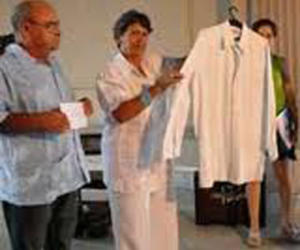Cuba's shirtmaker to the stars crafts handmade guayaberas
- Submitted by: manso
- Editorial Articles
- 06 / 21 / 2011

By: PETER ORSI , Associated Press. Updated: June 20, 2011 - 12:47 PM. HAVANA - Under fluorescent lights and a whirling ceiling fan that is no match for the Havana summer morning heat, Emiliano Nelson Guerra traced a pattern onto a bolt of pink cotton cloth and carefully scissored the edges.
Intermittently pulling on a fat cigar, he explained the significance of the "guayabera," the roomy, collared, four-pocketed dress shirts that Cubans wear to look spiffy on this tropical island where neckties are practically extinct.
"The guayabera is nothing less than the typical Cuban garment," Guerra said. "It's our image, so you always have to try to make it look its best."
Guerra, a 49-year-old with closely cropped hair and a receding hairline, is Cuba's shirtmaker to the stars. Known as Nelson to his friends, he has spent the last two decades establishing himself as Cuba's leading designer of the guayabera, which the government last year decreed the official formal attire for state functions.
He has hand-crafted shirts for international luminaries from American singer Harry Belafonte and British pop star Sting to Hugo Chavez, president of Venezuela, and Prince Albert of Monaco. E'Nelson Collection designs have exhibited in shows and fairs and been worn by world-renowned Cuban musicians like Chucho Valdes and the late Compay Segundo, of Buena Vista Social Club fame, and they're also in demand by wealthy foreigners and well-heeled Cubans up to the highest levels of government.
"One time I even made a guayabera for `el comandante,'" Guerra said, referring to former President Fidel Castro, known more for his affinity for military attire.
Guerra recalled the first time he met American actor Danny Glover, who has cultivated close ties to Cuba, about a decade ago at a film festival in Havana. He asked the "Lethal Weapon" star about the shirt he was wearing, which turned out to be an artesanal African garment. The shirtmaker soon found himself hurriedly assembling a bone-white, embroidered masterpiece that he gave to Glover the last night of the festival.
"He tried it out immediately," Guerra said. "He took off the shirt he was wearing, put mine on and said, `Excellent.'"
A year later the actor was back in town without the guayabera.
"He wasn't wearing it. Instead he told me, `I want another one!'" Guerra said, breaking into laughter at the memory. He said he has made three shirts so far for Glover.
Working under a Cuban law that lets artists and craftspeople operate independently, Guerra and his three assistants churn out 80 to 100 guayaberas a month.
In a country where official monthly wages average around $20, they sell in hotels and tourist shops for $49 for a casual short-sleeve, and $100 for a formal linen long-sleeve. He's also taken custom orders up to $229.
Guerra's most recent project for a high-profile client was making enough shirts to clothe an entire orchestra: 150 short-sleeved white guayaberas discounted at $40 a pop for the New York Philharmonic.
"He showed us a number of designs that were very creative and beautiful and took the idea of a traditional guayabera and brought them into a more contemporary context," said Eric Latzky, a Philharmonic spokesman who met with Guerra in Havana several months ago.
The group's plans to perform in Cuba in 2011 were called off for logistical reasons, but Guerra says there's enough demand for his shirts that he should be able to unload the 90 he's already made in a month or two.
Still, like any artist, he's disappointed he won't get to see the finished product up on stage.
"It's important to see your work at the end, in the place where it was going to be used," Guerra said. "To see the whole orchestra dressed up ... and even one man from the orchestra who apparently wears a size XXXXXL. I've never seen the man, but he must be gigantic."
Guerra's currently crafting guayaberas for Miami-based salsa musician Isaac Delgado, who's been wearing E'Nelson Collection since the 1990s, for his new album cover and upcoming European tour. Guerra proudly held up a demo: white-fronted with the entire back a red, white and blue Cuban flag.
"He's a tremendous designer with very good taste," said Massiel Delgado, the singer's wife and assistant.
Guerra founded his home workshop in historic Old Havana the mid-1990s with 10 initial designs that have today swelled to more than 100.
Cardboard patterns and photos of him with Glover, Sting and Segundo adorn the walls of the cutting table room. In an adjacent space, a painting of a Madonna gazing down at three people at sea in a rowboat hangs over early-1900s Singer sewing machines.
Guerra said Cuban guayabera making fell into decline after the revolution in 1959, as some cuts of fine cloth were in shorter supply and tastes changed. An invasion of Mexican Yucatan-style guayaberas, along with mass-production of shirts he called "barbarous," meant that handmade Cuban shirts all but disappeared.
There was a time when there wasn't much talk about the guayabera. In fact, young people — and many of them still have this idea — thought the guayabera was for old, overweight men."
Guerra's on a mission to change that, appearing on radio and TV to promote the shirts as a symbol of the national identity and even writing a tune in the Cuban musical tradition known as "son": "The guayabera is our national garb," goes the refrain.
"I've seen a lot of work that really leaves a lot to be desired," Guerra said. "I understand that everyone has to make money, but isn't it better to make money trying to create something good?"
Associated Press writer Gisela Salomon in Miami contributed to this report.
Source: //www.startribune.com/nation/124199438.html
Comments